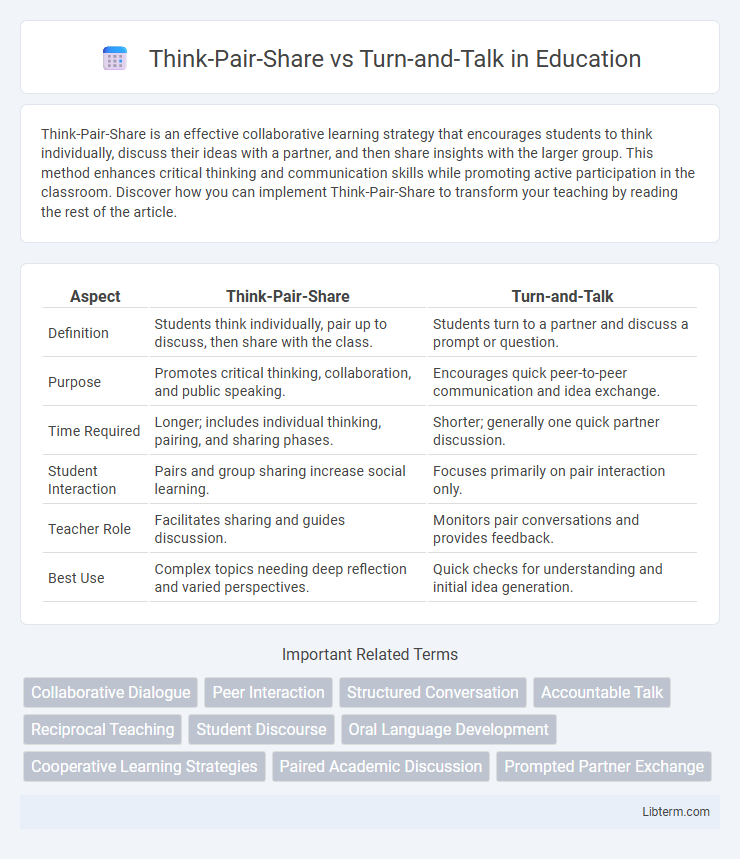Think-Pair-Share is an effective collaborative learning strategy that encourages students to think individually, discuss their ideas with a partner, and then share insights with the larger group. This method enhances critical thinking and communication skills while promoting active participation in the classroom. Discover how you can implement Think-Pair-Share to transform your teaching by reading the rest of the article.
Table of Comparison
| Aspect | Think-Pair-Share | Turn-and-Talk |
|---|---|---|
| Definition | Students think individually, pair up to discuss, then share with the class. | Students turn to a partner and discuss a prompt or question. |
| Purpose | Promotes critical thinking, collaboration, and public speaking. | Encourages quick peer-to-peer communication and idea exchange. |
| Time Required | Longer; includes individual thinking, pairing, and sharing phases. | Shorter; generally one quick partner discussion. |
| Student Interaction | Pairs and group sharing increase social learning. | Focuses primarily on pair interaction only. |
| Teacher Role | Facilitates sharing and guides discussion. | Monitors pair conversations and provides feedback. |
| Best Use | Complex topics needing deep reflection and varied perspectives. | Quick checks for understanding and initial idea generation. |
Introduction to Collaborative Learning Strategies
Think-Pair-Share and Turn-and-Talk are effective collaborative learning strategies that promote student engagement and critical thinking through structured peer interaction. Think-Pair-Share involves individual thinking time followed by paired discussion and sharing with the larger group, enhancing processing and articulation of ideas. Turn-and-Talk encourages brief, informal exchanges between partners to quickly deepen understanding and build communication skills without requiring full class participation.
What is Think-Pair-Share?
Think-Pair-Share is an active learning strategy where students first think individually about a question or problem, then pair up to discuss their ideas before sharing with the larger group. This method enhances critical thinking, encourages collaborative learning, and increases student engagement by allowing time for reflection and peer interaction. It is widely used in classrooms to promote deeper understanding and improve communication skills.
What is Turn-and-Talk?
Turn-and-Talk is an interactive teaching strategy where students quickly pair up to discuss a specific question or topic, promoting active engagement and verbal processing of ideas. This technique encourages all students to participate, enhances communication skills, and supports immediate feedback in a low-pressure setting. Unlike Think-Pair-Share, Turn-and-Talk typically involves shorter, more informal conversations aimed at building understanding before sharing with the larger group.
Core Differences Between Think-Pair-Share and Turn-and-Talk
Think-Pair-Share involves three structured steps where students first think individually, then pair up to discuss their thoughts, and finally share their conclusions with the larger group, promoting deeper cognitive processing and broader class engagement. Turn-and-Talk is a quicker, informal strategy where students immediately turn to a partner to discuss a prompt or question, emphasizing quick verbal exchanges and peer interaction without a formal subsequent sharing phase. The core difference lies in Think-Pair-Share's structured progression fostering collective insight versus Turn-and-Talk's rapid, spontaneous dialogue aimed at immediate verbal practice.
Benefits of Think-Pair-Share in the Classroom
Think-Pair-Share enhances student engagement by promoting individual thinking before collaborative discussion, leading to deeper comprehension and critical thinking skills. This strategy fosters active participation, boosts confidence in sharing ideas, and encourages diverse perspectives through structured peer interaction. Research shows that Think-Pair-Share improves retention and communication abilities, making it an effective tool for inclusive and interactive classroom environments.
Advantages of Turn-and-Talk for Student Engagement
Turn-and-Talk promotes immediate verbal interaction, increasing student participation and allowing for quick exchange of ideas in a low-pressure setting. This strategy enhances comprehension and retention by encouraging active listening and immediate articulation of thoughts. It supports diverse learners by providing frequent opportunities for peer collaboration and confidence building in classroom discussions.
When to Use Think-Pair-Share vs Turn-and-Talk
Think-Pair-Share is most effective during lessons requiring deep individual reflection followed by structured peer discussion, ideal for complex problem-solving or analytical tasks. Turn-and-Talk suits quick idea exchanges or formative assessments, facilitating immediate verbal processing and peer feedback. Use Think-Pair-Share for in-depth exploratory conversations and Turn-and-Talk for brief, interactive check-ins to maintain student engagement.
Classroom Scenarios and Examples
In classroom settings, Think-Pair-Share encourages individual thinking before collaboration, making it ideal for complex problem-solving tasks where students first formulate their own ideas, such as analyzing a poem or solving a math problem. Turn-and-Talk is more spontaneous, allowing students to discuss their thoughts quickly with a partner during lectures or readings, such as sharing immediate reactions to a historical event or summarizing a paragraph. Both strategies promote peer interaction but differ in structure: Think-Pair-Share follows a three-step process, while Turn-and-Talk emphasizes brief, informal exchanges.
Potential Challenges and Solutions
Think-Pair-Share can pose challenges like unequal participation and time management issues; instructors can mitigate these by setting clear guidelines and monitoring pairs closely. Turn-and-Talk may lead to off-topic discussions or limited depth of responses; solutions include providing focused prompts and time limits. Both strategies benefit from structured roles and active facilitation to maximize engagement and learning outcomes.
Conclusion: Choosing the Right Strategy for Your Students
Selecting between Think-Pair-Share and Turn-and-Talk depends on the lesson objectives and student engagement levels. Think-Pair-Share promotes deeper reflection by allowing individual thinking before discussion, making it ideal for complex problem-solving tasks. Turn-and-Talk suits quick exchanges and encourages active participation, especially in classrooms seeking to increase verbal interaction and immediate feedback.
Think-Pair-Share Infographic

 libterm.com
libterm.com